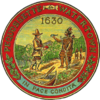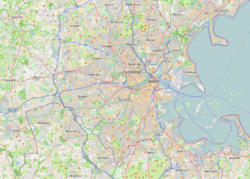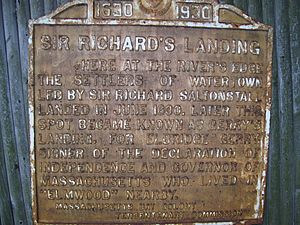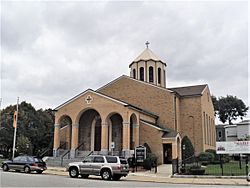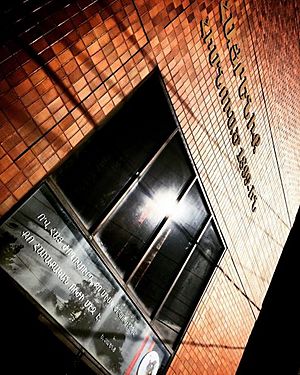Watertown, Massachusetts facts for kids
Quick facts for kids
Watertown, Massachusetts
|
|||
|---|---|---|---|
|
City
|
|||
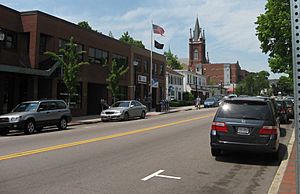
Watertown's Main Street, facing westward
|
|||
|
|||
| Motto(s):
In pace condita (Latin)
"Founded in peace" |
|||
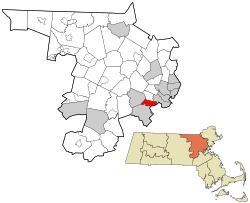
Location in Middlesex County in Massachusetts
|
|||
| Country | United States | ||
| State | Massachusetts | ||
| County | Middlesex | ||
| Settled | July 1630 | ||
| Incorporated | September 7, 1630 | ||
| Government | |||
| • Type | Council-manager | ||
| Area | |||
| • Total | 4.12 sq mi (10.68 km2) | ||
| • Land | 4.00 sq mi (10.35 km2) | ||
| • Water | 0.13 sq mi (0.33 km2) | ||
| Elevation | 36 ft (11 m) | ||
| Population
(2020)
|
|||
| • Total | 35,329 | ||
| • Density | 8,841.09/sq mi (3,413.41/km2) | ||
| Time zone | UTC−5 (Eastern) | ||
| • Summer (DST) | UTC−4 (Eastern) | ||
| ZIP Code |
02472
|
||
| Area code(s) | 617/857 | ||
| FIPS code | 25-73440 | ||
| GNIS feature ID | 0612401 | ||
| Website | www.watertown-ma.gov | ||
Watertown is a city in Middlesex County, Massachusetts, in the United States. It is part of the larger Greater Boston area. In 2020, about 35,329 people lived there. Watertown has several neighborhoods, including Bemis, Coolidge Square, East Watertown, Watertown Square, and the West End.
Watertown was one of the first places settled by Puritans in the Massachusetts Bay Colony in 1630. Today, it is home to the Perkins School for the Blind, the Armenian Library and Museum of America, and the historic Watertown Arsenal. The Arsenal used to make military weapons from 1816 until after World War II.
Contents
History
Long before Europeans arrived, people lived in the Watertown area for thousands of years. In the 1600s, two Native American groups, the Pequossette and the Nonantum, had villages along the Charles River. The Pequossette built a special fishing trap called a fishing weir to catch herring near where the Watertown Dam is now. Even today, every spring, fish like alewife and blueback herring swim upstream from the ocean to lay their eggs.
Early settlers first called the area Saltonstall Plantation. It was founded in 1630 by Richard Saltonstall and George Phillips. It officially became a town in the same year. For its first 25 years, Watertown was almost as big and populated as Boston. Over time, parts of Watertown became new towns like Weston (1712), Waltham (1738), Lincoln (1754), and Belmont (1859).
In 1632, people in Watertown protested paying a tax for a fort in Cambridge. This was an early protest against "taxation without representation" in America. It helped lead to the idea of representative democracy in the colony. By the late 1600s, Watertown was a main market for horses and cattle in New England. It was also known for its farms and beautiful estates. The first gristmill (for grinding grain) in the colony was built here around 1632. One of America's first woolen mills was built here in 1662. The oldest burying ground, on Arlington Street, was started in the 1660s. It has a monument for Joseph Coolidge, who was killed during the British retreat from Concord in April 1775.
Revolutionary War Era
Watertown was a very active place during the start of the American Revolutionary War. In 1773, many citizens joined the Sons of Liberty to protest the British Tea Tax. This protest led to the famous Boston Tea Party.
Later, in April 1775, about 134 Watertown minutemen quickly responded to the alarm from Lexington. They helped push back the British soldiers marching to Concord. Many of these citizen soldiers then joined the first battle lines during the Siege of Boston. Another Watertown citizen, Israel Bissel, was the first rider to carry the news of the British attack all the way to Connecticut, New York, and Philadelphia.
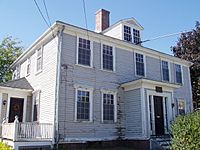
The Massachusetts Provincial Congress, a group of leaders, met in Watertown from April to July 1775. They met in the First Parish Church, where a monument now stands. On July 3, George Washington visited Watertown. The next day, he took command of the American Army in Cambridge. The Massachusetts General Court (the state's legislature) met here from 1775 to 1778. Committees often met in the nearby Edmund Fowle House. Boston town meetings were also held here during the siege of Boston, as many Boston families moved to Watertown for safety. For several months, the committees of safety and committee of correspondence used Watertown as their main office. From here, General Joseph Warren left for the Battle of Bunker Hill.
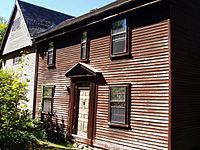
The Treaty of Watertown was the first treaty signed between the new United States of America and a foreign power. This treaty was with the St. John's and Mi'kmaq First Nations from Nova Scotia. It was signed in one of these historic houses.
Industrial Era
Mount Auburn Cemetery was created in 1831. It was the first garden cemetery in the United States. Its beautiful design inspired the first public parks and planned neighborhoods in the country. Most of this cemetery is actually located in Watertown, even though many think it is in Cambridge.
The Watertown Arsenal was a military factory and research center. It operated from 1816 until 1995. The Arsenal is famous for a strike in 1911. This strike happened because of new management methods by Frederick Winslow Taylor. His method, called "Scientific Management," broke down jobs into tiny steps. Workers were timed with stopwatches to find the fastest way to do tasks. This strike led to hearings in Congress, and in 1915, a law was passed to ban this method in government factories. Taylor's ideas, however, influenced many industries, including Henry Ford's assembly line.
After a big clean-up in the 1990s, the Watertown Arsenal area became a place for shopping, dining, and arts. It now includes the Arsenal Center for the Arts, which opened in 2005. The area also has two shopping malls, the Watertown Mall and Arsenal Yards.
The Stanley Brothers built their first steam-powered cars, known as Stanley Steamers, in Watertown in 1897. The Locomobile Company of America also made steam cars in Watertown starting in 1899, before moving to Connecticut.
21st Century
In April 2013, two suspects from the Boston Marathon bombing were found in Watertown. They had a long fight with the police. One suspect was badly hurt and later died. The town was completely closed off for many hours while police and federal agents searched for the other suspect. He was found and captured the next evening.
In November 2021, the people of Watertown voted to officially change the city's name to "The City of Watertown." Before this, it was called "The City Known as the Town of Watertown."
Geography
Watertown is located at 42°22′17″N 71°10′55″W. To the north, it borders Belmont. To the south, it borders Newton and the Brighton neighborhood of Boston. The Charles River forms much of the southern and eastern border. Most of Watertown is north of the Charles River. However, from Watertown Square, the city's border extends south of the river to include the area around Casey Playground.
To the east is the City of Cambridge. The border between them is mostly the well-known Mount Auburn Cemetery, which is mostly in Watertown. To the west is the city of Waltham. There isn't a clear natural feature or major road that divides these two cities.
The United States Census Bureau says Watertown has a total area of about 4.2 square miles (10.9 km²). About 4.1 square miles (10.6 km²) is land, and 0.1 square miles (0.3 km²) is water.
Neighboring Cities and Towns
 |
Belmont | Cambridge |  |
|
| Waltham | Boston | |||
| Newton |
Demographics
| Historical population | ||
|---|---|---|
| Year | Pop. | ±% |
| 1840 | 1,810 | — |
| 1850 | 2,837 | +56.7% |
| 1860 | 3,270 | +15.3% |
| 1870 | 4,326 | +32.3% |
| 1880 | 5,426 | +25.4% |
| 1890 | 7,073 | +30.4% |
| 1900 | 9,766 | +38.1% |
| 1910 | 12,875 | +31.8% |
| 1920 | 21,457 | +66.7% |
| 1930 | 34,913 | +62.7% |
| 1940 | 35,427 | +1.5% |
| 1950 | 37,329 | +5.4% |
| 1960 | 39,092 | +4.7% |
| 1970 | 39,307 | +0.5% |
| 1980 | 34,384 | −12.5% |
| 1990 | 33,284 | −3.2% |
| 2000 | 32,986 | −0.9% |
| 2010 | 31,915 | −3.2% |
| 2020 | 35,329 | +10.7% |
| 2022* | 35,022 | −0.9% |
| * = population estimate. Source: United States Census records and Population Estimates Program data. Source: |
||
In 2000, there were 32,986 people living in Watertown. There were 14,629 households and 7,329 families. The population density was about 8,026 people per square mile (3,099 per km²).
The racial makeup of the city was mostly White (91.42%). There were also African American (1.73%), Native American (0.16%), Asian (3.87%), and people from other races or two or more races. About 2.68% of the population was Hispanic or Latino.
The average household had 2.17 people, and the average family had 2.86 people. About 14.1% of the population was under 18 years old. The median age was 37 years.
Armenian Population
Watertown is a very important center for the Armenian diaspora in the United States. It has the third-largest Armenian community in the country, with an estimated 7,000 to over 8,000 Armenians as of 2007. Only Glendale and Fresno in California have more Armenians.
Watertown is also where several long-running Armenian newspapers are published. These include the Armenian Mirror-Spectator and the Armenian Weekly. There are also Armenian grocery stores in East Watertown that sell special foods and products from Armenia and the Mediterranean region.
Economy
Some of the main employers in Watertown include:
- Tufts Health Plan
- New England Sports Network
- The Perkins School for the Blind
- Exergen Corporation
- Vanasse Hangen Brustlin, Inc.
- Athenahealth
Transportation
Watertown is close to Soldiers Field Road and the Massachusetts Turnpike. These are major roads that lead into downtown Boston. The city is served by several MBTA bus routes. Most of these buses go through or end at Watertown Square or Watertown Yard. A branch of the MBTA's Green Line subway used to go to Watertown until 1969.
Education
Watertown Public Schools provides public education for about 2,600 students. It has three elementary schools, one middle school, and one high school (Watertown High School).
Private day schools in Watertown include:
- Perkins School
- St. Stephen's Armenian Elementary School
- Atrium School
There is also a special Armenian language school called St. James Erebuni Armenian School. It teaches both Western Armenian and Eastern Armenian to children. It is connected with the St. James Armenian Apostolic Church.
Notable People
- Benjamin Robbins Curtis (1809–1874), a judge who disagreed with the Dred Scott case decision.
- Eliza Dushku (born 1980), a film and TV actress who grew up in Watertown.
- Arshile Gorky (1904–1948), an Armenian-American painter who influenced Abstract Expressionism.
- Helen Keller (1880–1968), a famous author and activist, attended the Perkins Institute for the Blind.
- Tim Kurkjian, a baseball analyst for ESPN.
- Noah Kahan (born 1997), a singer and songwriter, moved to Watertown in 2022.
- Stephen P. Mugar (1901–1982), who founded Star Market and was a generous giver.
- Tui T. Sutherland, author of the Wings of Fire book series.
- Steven Van Zandt (born 1950), a guitarist for Bruce Springsteen's E-Street Band and an actor from The Sopranos.
Culture
Watertown has many interesting cultural places:
- The Armenian Library and Museum of America is at 65 Main Street.
- The Hairenik Association is at 80 Bigelow Avenue.
- The Perkins Braille and Talking Book Library is on the campus of the Perkins School for the Blind.
- The Watertown Free Public Library is at 123 Main Street. It has been recently updated.
- The Mosesian Center for the Arts is a regional arts center by the Charles River. It offers visual and performing arts, classes, and shows.
- The New Repertory Theatre is a professional theater company at the Mosesian Center for the Arts.
- The Watertown Children's Theatre at the Mosesian Center for the Arts has offered classes and shows for kids for 35 years.
- The Edmund Fowle House (built in 1772) and Museum is at 28 Marshall St. It is the second oldest house in Watertown.
- The Abraham Browne House (built around 1694–1701) is a colonial house at 562 Main Street. It is now a museum.
- Mount Auburn Cemetery, founded in 1831, has 151.1 acres of beautiful grounds with many types of trees and plants. It is Watertown's largest open space and extends into Cambridge. It also has the George Washington Tower.
- Gore Place is a historic house museum from the early 1800s. Part of its large estate is in Watertown.
- The Watertown Arsenal was a major American military arsenal. Its site is now a historic landmark and is on the U.S. National Register of Historic Places.
See also
 In Spanish: Watertown (Massachusetts) para niños
In Spanish: Watertown (Massachusetts) para niños



